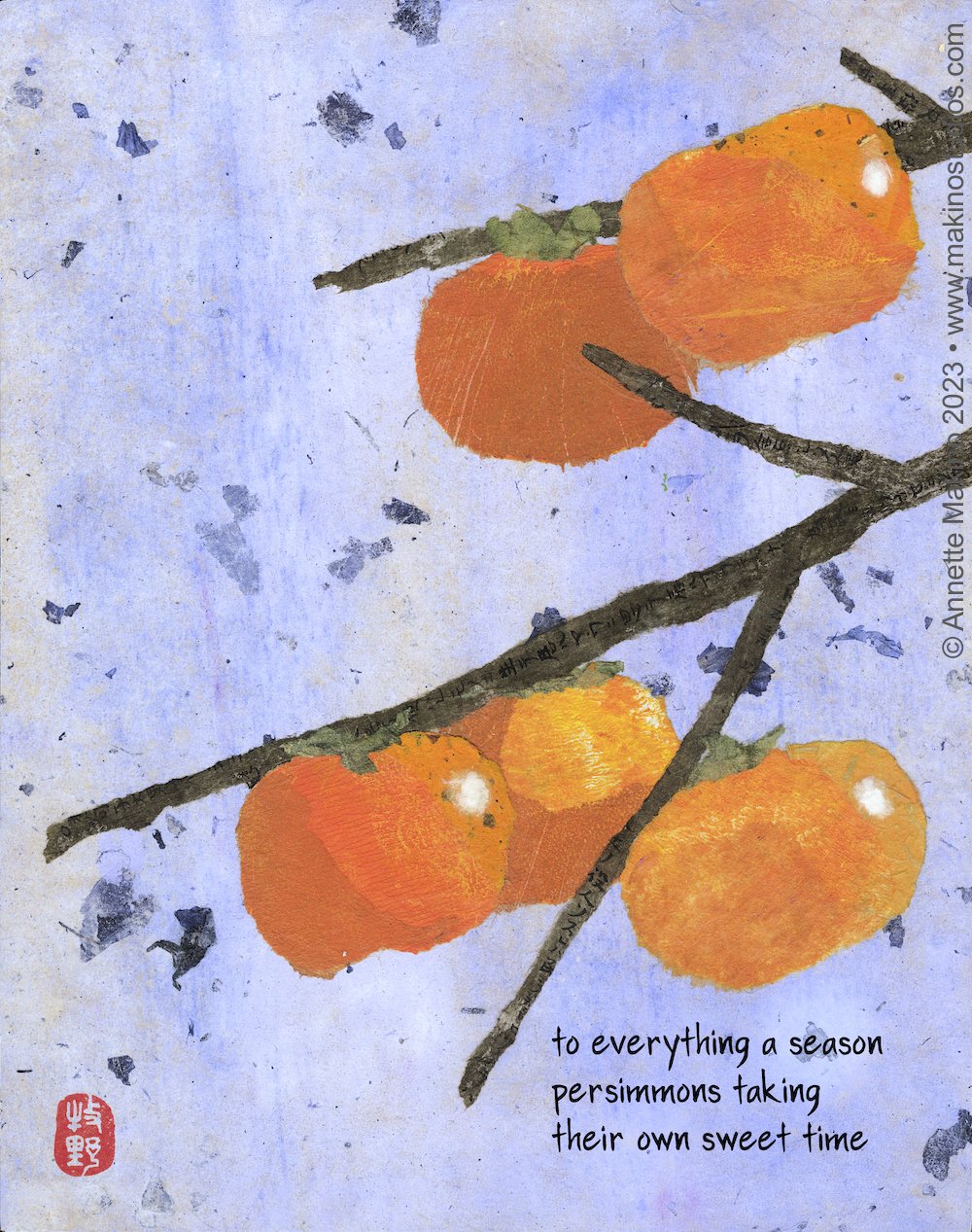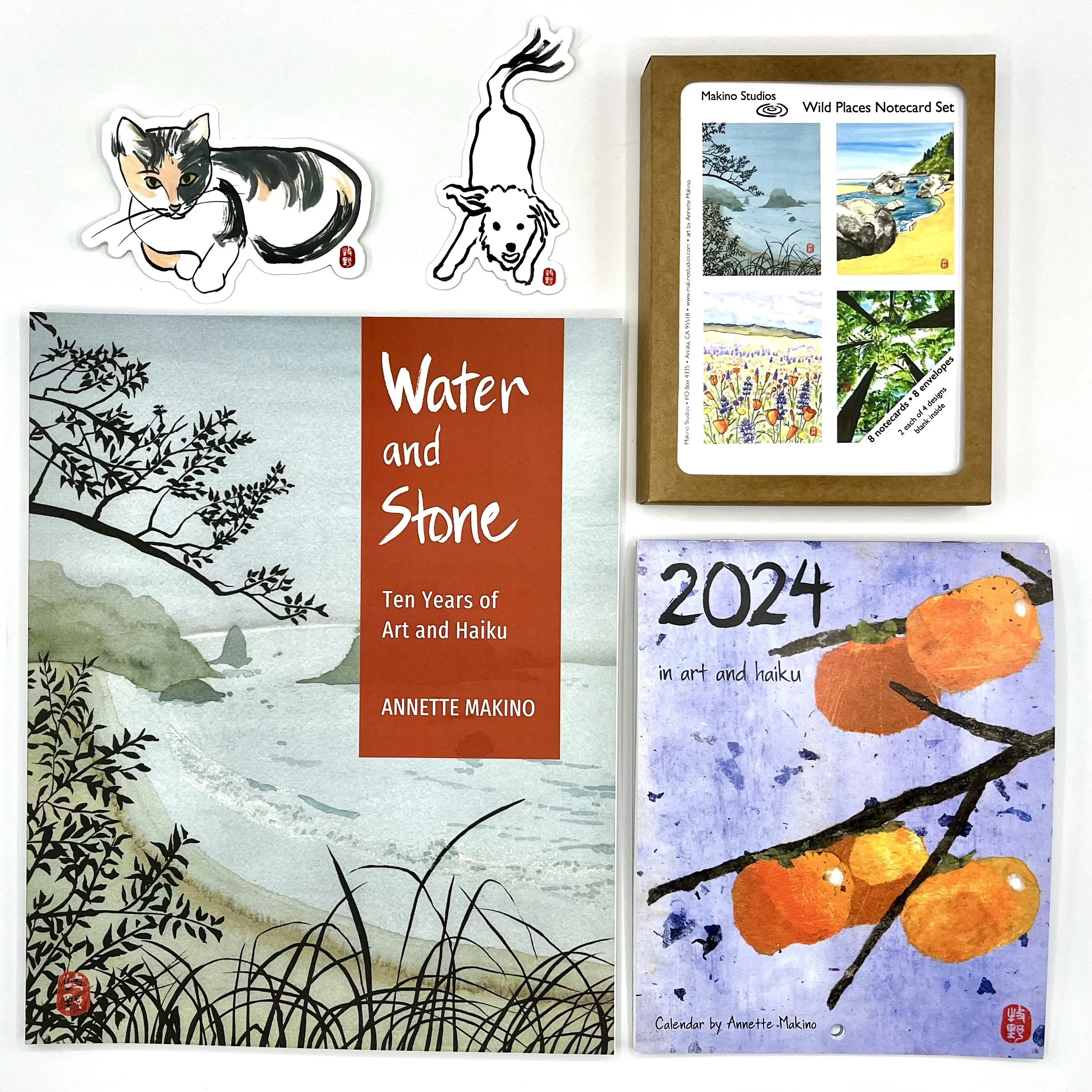“to everything a season” is 8x10, made of washi papers, acrylic paint, and glue on cradled wood panel. This is one of the pages of the 2024 calendar of art and haiku, and is available a holiday card or notecard set reading, “Wishing you joyful holidays”. © Annette Makino 2023.
Thanksgiving 1968. My kindergarten classmates and I dress up in pilgrim hats and Indian headbands for a “feast” of snacks at the classroom’s long formica tables. My hat, made from a paper plate and crumpled tissue paper flowers, is awkwardly tied under my chin with yarn.
It was the first of many whitewashed lessons about this holiday, touting peace and harmony between white European settlers and Native Americans. As a child, I was dubious about the fashion but never thought to question the story. Yet despite the version most of us learned in school, Thanksgiving has complex and dark beginnings.
When visiting my son at Whitman College last month, I got to see Larissa Fasthorse’s “The Thanksgiving Play." This is a very entertaining, satiric look at the efforts of four well-meaning white characters to produce a politically correct Thanksgiving play for an elementary school. Given the lack of Indigenous actors or writers, the characters reach the comically logical conclusion that the most respectful way to honor the Native American side of the story is to leave them out of the play altogether.
That is clearly an absurd solution. But how can we best celebrate a day with such a checkered history?
My kindergarten portrait, without the Pilgrim hat.
I focus on the Indigenous tradition of giving thanks for nature’s abundance, and to the practice of modern-day people, Indigenous and not, to focus on the gift of family. I’m also educating myself on the history behind Thanksgiving—the National Museum of the American Indian offers great resources.
The Haudenosaunee Thanksgiving Address, which expresses gratitude for all life, begins: “Today we have gathered and we see that the cycles of life continue. We have been given the duty to live in balance and harmony with each other and all living things. So now, we bring our minds together as one as we give greetings and thanks to each other as people. Now our minds are one.”
In that spirit, here’s wishing you a happy and abundant Thanksgiving.
•
Makino Studios News
Everything in the shop is 15% off with promo code THANKS23 through Sunday, Nov. 26!
Thanksgiving sale: Use promo code THANKS23 at checkout for 15% off everything in the Makino Studios shop except original art. No order minimum. Good for first-class shipping within the U.S. Only one promo code per order. Sale ends at midnight this Sunday, Nov. 26.
Made in Humboldt fair: The “Made in Humboldt” event at Pierson Garden Shop in Eureka, CA runs through Sunday, Dec. 24; there you will find my calendars, books, small prints and boxed notecards. There are 250 participating vendors, all local.
Holiday Craft Market: The only in-person fair I am doing this season takes place Saturday and Sunday, Dec. 9 and 10, at the Arcata Community Center in Arcata, CA. $1 admission. Catering by Mother’s Cooking Experience.
2024 mini-calendars: These calendars of art and haiku make great holiday gifts, as evidenced by the customers who buy 5, 10, even 20 at a time! They feature 12 colorful Asian-inspired collages with my original haiku. $12 each.
Water and Stone: My award-winning book of art and haiku includes 50 watercolor paintings with my original poems. Cost is $25. You can find it online here and in select local Humboldt stores.
Cards: Holiday, birthday, sympathy or everyday… right now there are almost 70 Makino Studios card designs to choose from, including eight new designs. I also have several notecard sets, including holiday designs.
Art prints: Blake’s Books in McKinleyville carries a selection of my art prints, ready for gifting. They are among the local stores that carry my books, calendars, notecards and single cards.
Holiday order deadline: If you’d like your package to arrive by December 25, please order by Friday, December 15. Makino Studios ships via USPS Ground Advantage and First-class mail. The elves are standing by!




